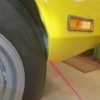I don't understand "as a bonus". With smaller tires, it takes more torque and therefore press harder on the pedal to have the same force between the tire and the road and it's this force that brakes the car, not the torque.
...Yes! You have it right!! Torque is a Force over an Arm (length of the Lever), which Can create a Rotation around an axis. In this Case of Brakes...this would be the Radius of the Tire (yes it's Flat on the bottom) The Shorter Radius 'Requires' a 'Slightly' greater force on the Pads, which means a greater force on the Pedal, Correct!
The Bonus I speak of is...a More 'Sensitive' Braking Response and a Faster Stopping of the Rotor. On My Pantera, when I stop, I don't notice any Increase in the Pedal Effort, Undetectable!! The car stops immediately, "On a Dime" as they say. The Nose will 'Dive' Slightly and then 'Blips' up, Once, in return. Just as you would see in a Ferrari, Lamborghini or any other Exotic. To ME, This IS a Bonus!!
...on last thing, take a good look at the 'Racing' Panteras, they run in Europe! A Very Small Front Tire with a 'Gigantic' Rear Tire! Those guys know the Physics of what I speak. They don't use Small tires up front for No Good Reason...or because they may Look Pretty, Mean, or Impress 14 Year Old Girls! LOL
...Yes, pressure on the pads, and friction of the tire on the road, stops the car...The Resistance to the 'Rotational Torque' is what 'Creates' It!
With the LARGER tire, the 'Arm' is Greater and the 'Resistance to Rotational Torque' Decreases along with a Lesser Pedal Effort, although the change in the Effort is undetectable...the Brake Pads take more time to stop the Rotor, the Car must travel farther before a Full Stop.
Next Challenge??
MJ


